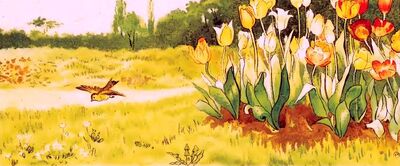
19th century illustration for "The Daisy" by Alice Havers.
"The Daisy" (Danish: "Gåseurten") is a short fantasy story for children by the Danish author Hans Christian Andersen. It was first published on October 2, 1838, along with "The Steadfast Tin Soldier" and "The Wild Swans", as part of the anthology Fairy Tales Told to Children New Collection First Booklet (Danish: Eventyr, fortalte for Børn. Ny Samling. Første Hefte).
The story concerns a daisy and a lark. The flower and the bird both thrive in their natural surroundings. When children take them out of those surroundings, they both soon die.
Plot[]
A patch of grass grows in front of a flower garden full of roses, tulips and peonies. A daisy grows on the patch of grass. The little flower knows that it is not as beautiful or as fragrant as the flowers which grow in the garden. The daisy is, however, perfectly happy. It enjoys its beautiful surroundings and being nourished by the sun.
One morning, the daisy hears the song of a lark and sees the bird flying overhead. The daisy is certain that the lark will fly down to the pretty roses, tulips and peonies in the garden. To the daisy's surprise and delight, when the lark lands, it ignores all the flowers in the garden and is only interested in the daisy. It hops around the daisy while singing about how beautiful the little flower is.
The following morning, the daisy hears the song of the lark again. This time, however, the song sounds sad. The reason for this is because the lark has been captured and put in a cage. The daisy wants to set the lark free, although it realizes that it does not have the power to help the bird in any way. The daisy can only think of the unfortunate lark and pays no attention to its beautiful surroundings.

Illustration for "The Daisy" from the 1850 American book Little Ellie and Other Tales.
Two boys go to get a piece of turf to put in the lark's cage. The piece of turf which they cut up has the daisy in it. By the time that the piece of turf is put in its cage, the lark is already starting to die because it has not been given any water. It recognizes the daisy but is not comforted by seeing the flower. The bird realizes that the daisy will also die inside the cage. The sight of the daisy also unhappily reminds the lark of the freedom which it has lost. The daisy is still desperate to help the lark. As a result, the little flower becomes unusually fragrant for a daisy. The lark notices this. Although the bird tears up every piece of grass in an attempt to quench its thirst, it leaves the daisy untouched.
By the following morning, both the daisy and the lark are dead. The two boys, who imprisoned and neglected the bird when it was alive, are deeply saddened by its death. They hold a funeral for the lark. Knowing nothing about the daisy which wanted to help and comfort the bird, they throw away the piece of turf.
External links[]
- Versions of Hans Christian Andersen's "The Daisy" in Danish and English on Wikisource.
- Public domain audiobook of "The Daisy" on YouTube.
